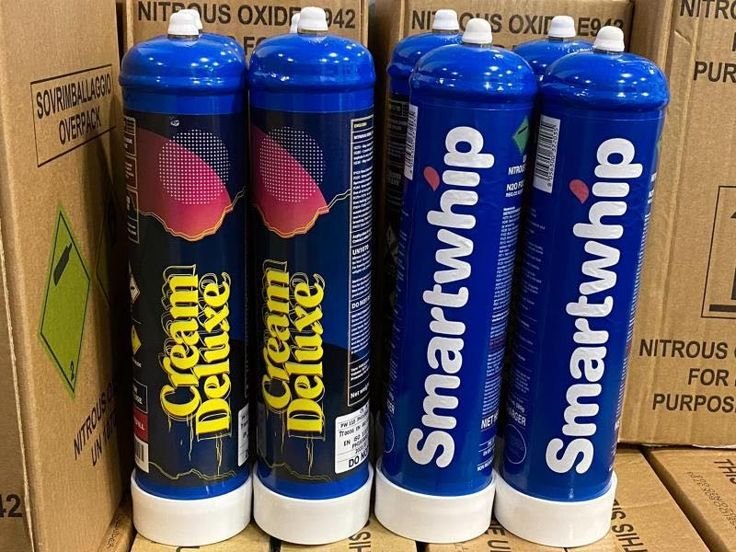Cream chargers don’t expire overnight—but poor storage can silently damage gas quality, packaging, or compliance.
Properly stored N2O cream chargers last up to 5 years. To keep them compliant and high-performing, distributors must control humidity, temperature, labeling, and batch rotation.

If you manage a warehouse, plan international shipments, or store tanks long-term, this guide covers every critical point you should monitor.
What’s the Shelf Life of a Cream Charger?
Shelf life isn’t just a printed number—it’s based on material, sealing, and storage quality.
Steel and aluminum cream chargers typically have a 5-year shelf life from the production date, assuming ideal indoor storage.
Shelf Life Overview
| Material Type | Typical Shelf Life | Key Risk Factors |
| Steel tank | 5 years | Surface rust, label fading |
| Aluminum tank | 5–7 years | Less corrosion, more stable |
| Uncoated steel | ≤3 years | Humidity-sensitive |
📌 Tip: Always confirm the production date on the steel stamp or box label—not just the invoice.
What Are the Correct Storage Conditions for Cream Chargers?
A cool, dry, indoor space isn’t optional—it’s required by most safety and transport standards.
N2O tanks must be kept upright in ventilated rooms below 50°C, away from heat, chemicals, or crushing force.
Key Storage Guidelines
| Condition | Standard |
| Temperature | Ideal: 10–30°C (Max: 50°C) |
| Humidity | ≤65%, no standing moisture |
| Stacking method | Upright, stable, on clean pallets |
| Floor type | Elevated or dry concrete |
| Proximity rules | Away from flammable or corrosive goods |
📌 Avoid storing tanks inside sealed shipping containers under sun exposure—risk of pressure swelling or leakage.
How Should Labels Be Handled for Expiry Tracking?
Missing or faded labels can lead to customs rejection or product recalls.
Make sure every box or tank carries clear expiry, production, and batch information, and choose between printed or sticker labels based on export market needs.
| Label Requirement | Market | Note |
| Expiry date on box | EU / Australia | Mandatory for retail food goods |
| Batch number | Global | Needed for traceability |
| QR code (optional) | High-end OEM | Used for anti-counterfeit & tracing |
| Print vs sticker | Buyer’s choice | Print = durable, sticker = flexible |
📌 Damaged labels may legally void shelf life—even if the tank is still sealed.
How Should You Manage Stock Expiry and Batch Rotation?
One bad shipment with expired or faded tanks can hurt brand trust—or be stopped at customs.
Use FIFO (First In, First Out) and always label each pallet with production and expiry dates clearly.
Inventory Rotation Best Practices
| Step | Why It Matters |
| Batch labeling by month | Ensures quick traceability |
| Internal alert threshold | Flag stock 6 months before expiry |
| Visual QC at intake | Detects early rust, dent, or fade |
| Supplier return clause | Protects against premature expiry loads |
📌 European regulations require visible expiry dates for cream chargers intended for food or beverage use.
What Risks Come from Improper Storage?
Even unopened tanks degrade in the wrong environment.
Heat, moisture, and poor stacking can cause pressure instability, leakage, or brand-damaging residue inside the valve.
Common Errors to Avoid
| Storage Error | Resulting Risk |
| Direct sunlight | Tank swelling, paint blistering |
| Humid container floors | Rust stains, weakened steel shell |
| Horizontal stacking | Valve damage, dented base |
| Mixed pallets with food | Regulatory violation, recall risk |
📌 Improper storage can void warranty or safety certifications.
Can Expired Cream Chargers Still Be Used?
Legally and practically, it’s risky.
While N2O is chemically stable, expired tanks may have degraded valves, weakened metal, or labeling issues that make them unfit for sale.
- Expiry dates are required for import/export declarations in many countries.
- Reselling expired cream chargers may violate local food or gas safety laws.
- In B2B or white-label supply, expired goods can damage your brand reputation.
📌 Set a cut-off period in your SOP (e.g., stop selling when 6 months remain before expiry).
What About Long-Term Storage for Export?
If you’re holding stock for global buyers, standards matter.
N2O chargers are UN1070 Dangerous Goods. Most countries apply DG rules to both storage and labeling during export.
Export Storage Notes
| Mode | Regulation to Follow |
| Ocean FCL | IMDG, steel/plywood packing |
| Ocean LCL | Often prohibited for N2O tanks |
| Air Freight | IATA, strict volume limits |
| Cross-border B2B | Labeling + expiry info required |
📌 For food-grade access to EU or AU, use certified products. 👉 See our CE and TPED compliant N2O tanks →
Conclusion
Shelf life isn’t just a number. It’s a reflection of how you store, label, and rotate your stock. For distributors and exporters, proper N2O tank storage means fewer losses, full compliance, and long-term brand protection.




